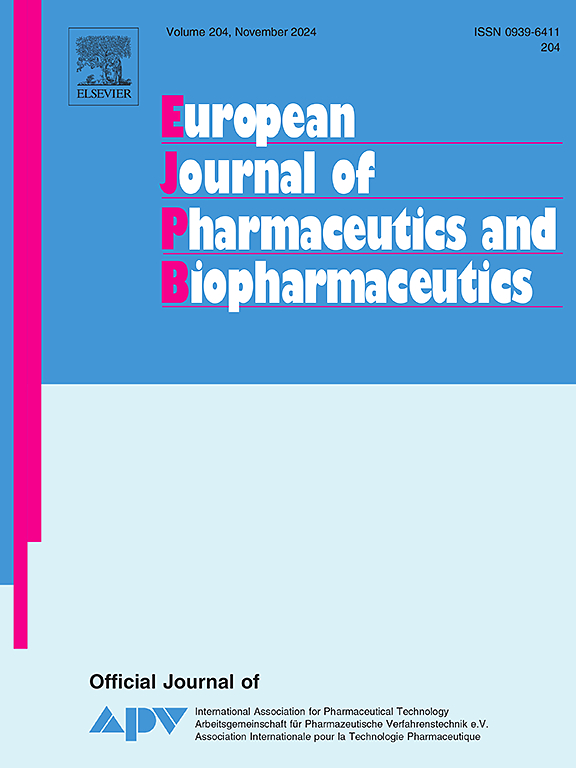迷你平板电脑的复兴:最近的进展,分类和对未来的期望。
IF 4.4
2区 医学
Q1 PHARMACOLOGY & PHARMACY
European Journal of Pharmaceutics and Biopharmaceutics
Pub Date : 2025-02-06
DOI:10.1016/j.ejpb.2025.114655
引用次数: 0
摘要
迷你片剂最近引起了制药行业的极大兴趣。本综述旨在通过遵循PRISMA算法的结构化文献综述,确定这种新兴的小固体药物剂型的合理性、机遇和挑战。总的来说,从上个世纪60年代( )的第一个文献和专利来源开始,已经发现了5000多个文献和专利来源,随后是1985年授权的第一个使用胰蛋白酶迷你片剂的多特异性产品(Panzytrat®由前巴斯夫子公司Knoll/Nordmark开发)。在2000年 年代,临床研究表明,即使对包括新生儿在内的非常年轻的患者,一种或多种迷你片剂也能比以前的黄金标准——液体药物制剂——提供更好的药物管理,这似乎是共同兴趣的第二次提升。几家制药公司立即启动了使用迷你片剂概念的临床开发项目,首批产品最近已获得主管部门的批准。与传统片剂相比,迷你片剂的优势在于吞咽过程更容易,能够通过薄膜涂层技术实现各种改良药物释放机会,包括掩盖味道,并且与液体口服剂型相比,具有出色的药物稳定性。由于这些产品的属性,它们对儿童和他们的照顾者特别有益。此外,通过计算多种药物载体的适当量,有可能精确地给药。最近,EMA批准了两种不同概念的新产品进入市场,这两种产品在本综述中得到了强调:第一种用于先天性心力衰竭的马来酸依那普利或分散型迷你片(Proveca Pharma的Aqumeldi®)和第一种用于失眠的基质型控制褪黑激素释放的单片迷你片(Neurim Pharmaceuticals的Slenyto®)。我们的审查显示,大多数发表的科学论文使用共同加工的、即用的赋形剂作为非分散迷你片剂配方。然而,传统的填充物,如微晶纤维素或乳糖,也被用于添加(超级)崩解剂和润滑剂后的立即释放迷你片。微型片剂的制造是在传统的旋转片剂压机上进行的,主要配备多尖端模具,以提高产量或生产速度。成功地实现了从压实模拟器到中试和生产规模的规模化。利用与传统片剂相同的聚合物,在流化床和滚筒涂布机中实现了具有胃抵抗、掩盖味道或缓释特性的薄膜涂层。尽管最近迷你片概念取得了成功,但从药典中合适的表征方法到迷你片临床研究的设计和实施,监管指导仍然明显缺乏。本文章由计算机程序翻译,如有差异,请以英文原文为准。

The revival of the mini-tablets: Recent advancements, classifications and expectations for the future
Mini-tablets have recently raised huge interest in pharmaceutical industry. The present review aims to identify the rational, the opportunities and challenges of this emerging small solid drug dosage form by a structured literature review following the PRISMA algorithm. In total, more than 5,000 literature and patent sources have been found starting with the very first in the 60s of the past century, followed by the first multiparticular products using mini-tablets with pancreatin (Panzytrat® by the former BASF subsidiary Knoll/Nordmark) authorized in 1985. There seems to be a second boost of common interest in the 2000s when clinical studies demonstrated that one or more mini-tablets could enable superior drug administration even in very young patients including neonates over the former gold standard, a liquid drug preparation. Several pharmaceutical companies immediately started clinical development programs using the mini-tablet concept and the first products have been recently authorized by the competent authorities. Superiority was given as the mini-tablets ease the swallowing procedure compared to conventional tablets, enable various modified drug release opportunities including taste-masking by film-coating technology and provide excellent drug stability compared to liquid oral dosage forms. Due to these product attributes they are particularly beneficial to children and their caregivers. Furthermore, there is potential for precise individual drug dosing by counting adequate amounts of the multiple drug carriers. Most recently, two novel products with different concepts were authorized by the EMA and entered the market which are highlighted in this review: the first orodispersible mini-tablet with enalapril maleate for congenital heart failure (Aqumeldi® from Proveca Pharma) and the first single unit mini-tablet with matrix-type controlled melatonin release for insomnia (Slenyto® from Neurim Pharmaceuticals).
Our review reveals, that the majority of the published scientific papers use co-processed, ready-to-use excipients for the orodispersible mini-tablet formulations. However, traditional fillers such as microcrystalline cellulose or lactose have also been used for immediate release mini-tablets after adding a (super)disintegrant and a lubricant. The manufacturing of mini-tablets is conducted on conventional rotary tablet presses, predominantly equipped with multi-tip toolings to improve the yield or production speed. Scaling-up has been successfully realized from compaction simulators to pilot and production scale. Film-coatings enabling gastric resistance, taste masking or sustained-release properties have been realized in both fluid-bed and drum coaters using the same polymers as for conventional tablets. There is still a significant lack in regulatory guidance despite the recent success of the mini-tablet concept, starting from suitable characterization methods in the pharmacopoeias up to the design and conduct of clinical studies on mini-tablets.
求助全文
通过发布文献求助,成功后即可免费获取论文全文。
去求助
来源期刊
CiteScore
8.80
自引率
4.10%
发文量
211
审稿时长
36 days
期刊介绍:
The European Journal of Pharmaceutics and Biopharmaceutics provides a medium for the publication of novel, innovative and hypothesis-driven research from the areas of Pharmaceutics and Biopharmaceutics.
Topics covered include for example:
Design and development of drug delivery systems for pharmaceuticals and biopharmaceuticals (small molecules, proteins, nucleic acids)
Aspects of manufacturing process design
Biomedical aspects of drug product design
Strategies and formulations for controlled drug transport across biological barriers
Physicochemical aspects of drug product development
Novel excipients for drug product design
Drug delivery and controlled release systems for systemic and local applications
Nanomaterials for therapeutic and diagnostic purposes
Advanced therapy medicinal products
Medical devices supporting a distinct pharmacological effect.

 求助内容:
求助内容: 应助结果提醒方式:
应助结果提醒方式:


